英文电影配音选修课教案精选文档
英文播音课程教案模板范文

Subject: Introduction to English BroadcastingTeaching Aims:1. To familiarize students with the basic concepts and principles of English broadcasting.2. To enhance students' speaking and listening skills in English.3. To train students in the proper use of language and tone in broadcasting.4. To foster students' creativity and confidence in public speaking.Teaching Objectives:1. Students will be able to define what broadcasting is and understand its role in media.2. Students will demonstrate an understanding of the different types of broadcasting, such as radio, television, and online.3. Students will be able to identify and use appropriate broadcasting language and tone.4. Students will be able to prepare and deliver a short broadcast piece.Teaching Key Points:1. Understanding the fundamentals of broadcasting.2. Mastering broadcasting language and tone.3. Practicing delivery techniques for effective broadcasting.Teaching Methods:- Lectures- Group discussions- Role-playing exercises- Listening and analysis of real broadcasting clips- Hands-on practice sessionsTeaching Process:Week 1: Introduction to Broadcasting- Introduction: Briefly introduce the course, the importance of broadcasting, and what students can expect to learn.- Lecture: Explain the basic concepts of broadcasting, including its history, evolution, and its current role in the media landscape.- Group Discussion: Have students discuss the differences between broadcasting and other forms of media, such as print and online.Week 2: Types of Broadcasting- Lecture: Discuss the various types of broadcasting, including radio, television, and online.- Role-Playing Exercise: Students role-play different scenarios, such as a news anchor reporting live, a sports commentary, or a weather forecast.- Listening and Analysis: Play a segment of a real broadcasting clip and have students analyze the language and delivery style.Week 3: Broadcasting Language and Tone- Lecture: Explain the importance of appropriate language and tone in broadcasting.- Hands-On Practice: Students practice using broadcasting language and tone in short scripts.- Feedback: Provide constructive feedback on students' practice sessions.Week 4: Delivery Techniques- Lecture: Discuss techniques for effective delivery, such as voice modulation, body language, and engagement with the audience.- Group Discussion: Students discuss the importance of confidence and preparation in broadcasting.- Practice Session: Students prepare and deliver a short broadcast piece, focusing on delivery techniques.Week 5: Final Project Preparation- Group Work: Students form groups to plan and prepare a final broadcasting project.- Guidance: Provide guidance on project requirements and offer supportas needed.Week 6: Final Project Presentation- Presentation: Students present their final broadcasting projects tothe class.- Feedback: Offer feedback on the projects and celebrate the students' achievements.Homework:- Reading: Assign relevant readings on broadcasting history and techniques.- Listening: Provide a list of broadcasting clips for students to listen to and analyze.- Writing: Assign a short writing task related to broadcasting, such as writing a script for a news report or a weather forecast.Assessment:- Participation: Active participation in class discussions and exercises.- Role-Playing: Performance in role-playing exercises.- Final Project: Quality of the final broadcasting project.- Homework: Completion and quality of homework assignments.Auxiliary Materials:- Textbooks on broadcasting- Online resources and articles on broadcasting - Recording equipment for practice sessions- Access to real broadcasting clips for analysis。
小学英语电影配音教案
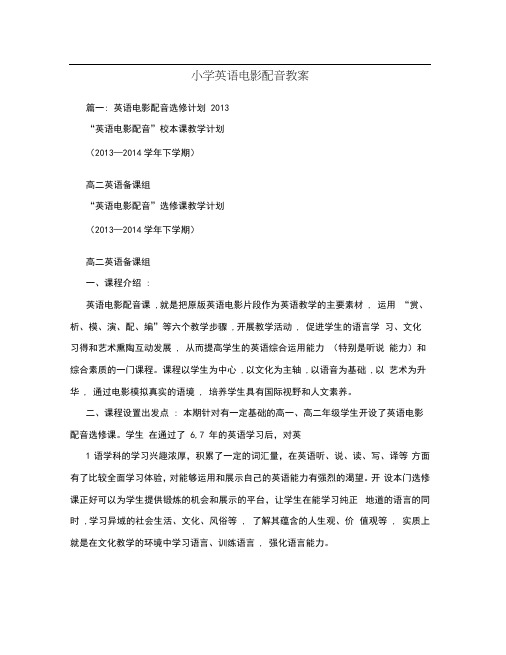
小学英语电影配音教案篇一: 英语电影配音选修计划 2013“英语电影配音”校本课教学计划(2013—2014学年下学期)高二英语备课组“英语电影配音”选修课教学计划(2013—2014学年下学期)高二英语备课组一、课程介绍 :英语电影配音课 ,就是把原版英语电影片段作为英语教学的主要素材 , 运用“赏、析、模、演、配、编”等六个教学步骤 ,开展教学活动 , 促进学生的语言学习、文化习得和艺术熏陶互动发展 , 从而提高学生的英语综合运用能力(特别是听说能力)和综合素质的一门课程。
课程以学生为中心 ,以文化为主轴 ,以语音为基础 ,以艺术为升华 , 通过电影模拟真实的语境 , 培养学生具有国际视野和人文素养。
二、课程设置出发点 : 本期针对有一定基础的高一、高二年级学生开设了英语电影配音选修课。
学生在通过了 6,7 年的英语学习后,对英1 语学科的学习兴趣浓厚,积累了一定的词汇量,在英语听、说、读、写、译等方面有了比较全面学习体验,对能够运用和展示自己的英语能力有强烈的渴望。
开设本门选修课正好可以为学生提供锻炼的机会和展示的平台,让学生在能学习纯正地道的语言的同时 ,学习异域的社会生活、文化、风俗等 , 了解其蕴含的人生观、价值观等 , 实质上就是在文化教学的环境中学习语言、训练语言 , 强化语言能力。
三、课程目标 :(一)知识与技能1. 在学生已有基础上拓展其词汇量,学习地道的英语语言。
2. 让学生了解西方文化,从生活体验、艺术享受、文化熏陶等方面培养其跨文化交际能力。
(二)过程与方法1. 分析电影角色,模仿台词,进行角色配音。
2. 与团队进行分工合作,完成配音表演。
3. 借助电影原声,能用正确、纯正的英语表达自己。
(三)情感、态度、价值观1. 激发和保持学生的英语学习兴趣,将兴趣转化为稳定的学习动机,形成客服困难的意志,在不断的实践中提高英语学习的自信心。
2. 让学生在实践中明白团结协作的重要性(转载于:小龙文档网: 小学英语电影配音2教案),乐于与他人合作,养成和谐与健康向上的品格。
英文配音美学教案模板范文
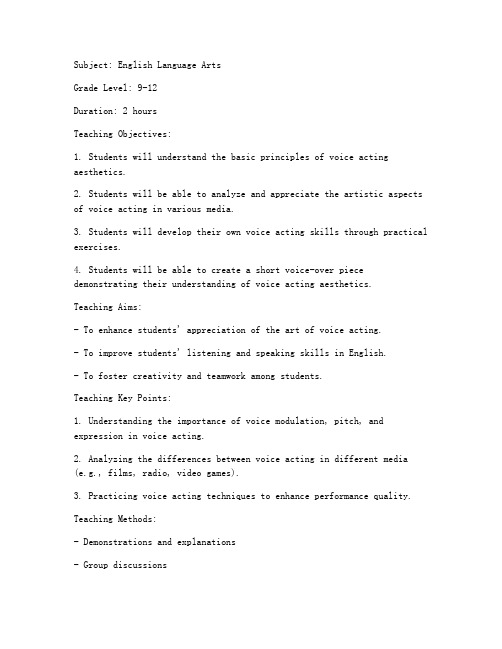
Subject: English Language ArtsGrade Level: 9-12Duration: 2 hoursTeaching Objectives:1. Students will understand the basic principles of voice acting aesthetics.2. Students will be able to analyze and appreciate the artistic aspects of voice acting in various media.3. Students will develop their own voice acting skills through practical exercises.4. Students will be able to create a short voice-over piece demonstrating their understanding of voice acting aesthetics.Teaching Aims:- To enhance students' appreciation of the art of voice acting.- To improve students' listening and speaking skills in English.- To foster creativity and teamwork among students.Teaching Key Points:1. Understanding the importance of voice modulation, pitch, and expression in voice acting.2. Analyzing the differences between voice acting in different media(e.g., films, radio, video games).3. Practicing voice acting techniques to enhance performance quality.Teaching Methods:- Demonstrations and explanations- Group discussions- Practical exercises- Peer review and feedbackTeaching Process:I. Introduction (10 minutes)- Briefly introduce the concept of voice acting and its importance in various media.- Explain the purpose of the lesson and the learning objectives.- Show a short clip of a well-executed voice-over performance to set the tone for the lesson.II. Theoretical Instruction (20 minutes)- Discuss the basic principles of voice acting aesthetics, including voice modulation, pitch, expression, and intonation.- Explain the differences between voice acting in different media and the specific requirements for each.- Provide examples of successful voice-over performances to illustrate the discussed principles.III. Group Discussion (15 minutes)- Divide the class into small groups.- Each group will discuss and analyze a voice-over performance, identifying the elements of voice acting aesthetics that were used effectively.- Each group will present their findings to the class.IV. Practical Exercises (40 minutes)- Break the class into pairs.- Each pair will be given a scenario or script to practice voice acting.- Students will focus on voice modulation, pitch, and expression tobring the script to life.- Pairs will record their voice-over performances.V. Peer Review and Feedback (15 minutes)- Each pair will present their recorded voice-over performance to the class.- The class will provide constructive feedback on the voice acting techniques demonstrated.- The teacher will also offer guidance and suggestions for improvement.VI. Creative Project (30 minutes)- In groups of three, students will create a short voice-over piece based on a given scenario or story.- Students will work together to write the script, record the voice-over, and edit the final product.- Each group will present their voice-over piece to the class for feedback.VII. Conclusion (10 minutes)- Summarize the key points discussed during the lesson.- Encourage students to continue exploring voice acting aesthetics outside of the classroom.- Assign a reflective writing task, asking students to reflect on their learning experience and identify areas for improvement.Assessment:- Participation in class discussions and group activities- Quality of voice-over performances- Reflective writing assignmentMaterials Needed:- Projector and screen- Short voice-over clips for analysis- Scripts for practical exercises- Recording devices- HeadphonesNote: This template can be adapted to different grade levels and learning environments as needed.。
配音英语教学课程设计

配音英语教学课程设计一、课程目标知识目标:1. 学生能够掌握并运用英语课本中学过的基本词汇和句型进行简单的配音表演;2. 学生能够理解并复述英语课本剧中的对话内容,提高听力理解能力;3. 学生能够了解英语口语表达的基本技巧,如语调、节奏、连读等,并能在配音过程中加以运用。
技能目标:1. 学生通过参与配音活动,提高英语口语表达能力,增强语言实践能力;2. 学生能够在团队协作中发挥个人特长,培养合作精神和沟通能力;3. 学生能够运用所学知识,独立完成一段英语课本剧的配音。
情感态度价值观目标:1. 学生对英语学习保持积极的态度,增强自信心,勇于展示自我;2. 学生在配音活动中体验英语学习的乐趣,培养学习英语的兴趣;3. 学生通过学习英语课本剧,了解不同文化背景,尊重和接纳多元文化。
课程性质:本课程为英语口语实践课程,旨在通过配音活动,让学生在实际语境中运用所学知识,提高英语口语表达能力。
学生特点:学生处于小学高年级阶段,具备一定的英语基础,对英语学习有较高的兴趣,喜欢参与互动性强的活动。
教学要求:教师需关注学生的个体差异,提供有针对性的指导,鼓励学生积极参与配音活动,提高英语口语表达能力。
同时,注重培养学生的合作精神和沟通能力,使学生在轻松愉快的氛围中学习英语。
通过课程目标的分解,为后续的教学设计和评估提供明确的方向。
二、教学内容本课程以英语课本中涉及的日常对话和故事情节为基础,选取适合配音的片段进行教学。
教学内容主要包括以下几部分:1. 词汇学习:选取与配音片段相关的核心词汇,如人物、地点、物品等,帮助学生巩固词汇记忆。
2. 句型掌握:总结配音片段中的常用句型,让学生在实际语境中练习并掌握。
3. 对话理解:分析课本剧中的对话内容,提高学生的听力理解能力。
4. 口语技巧:教授语调、节奏、连读等口语表达技巧,提高学生的配音表现力。
5. 团队合作:组织学生分组进行配音练习,培养合作精神和沟通能力。
教学内容安排与进度:第一周:学习与配音片段相关的词汇和句型,进行基本口语技巧的训练。
英文电影配音选修课教案

英文电影配音选修课教案-CAL-FENGHAI-(2020YEAR-YICAI)_JINGBIAN《原音影视配音与英语学习》 Big Hero 6教学设计(第一课时)广西民族师范学院附属中学英语组宁庆银一.教学目标以学生的接受能力为基准,借助精彩的英语原版影视片断为教学平台,采取视,听,说,读相结合的手段,注重课堂教学的实效性和操作性,在声音,图像和文本多重信息作用下,使学生的英语表达能力得到较快提升。
通过影片的配音实践,激发学生的表演才能,提高学生的艺术素养;走进影片主人公的精神世界,不自觉的和影片主人公产生心灵的共鸣,反映出深刻的理性内涵,激发学生的道德需要,调动学生主动追求高尚人格,利用影片强烈的教育功能和强大的教育征服力,培养学生真善美的情感。
二.教学重点通过对电影Big Hero 6 的欣赏及配音表演使学生的英语表达能力得到较快提升,激发学生的表演才能,提高学生的艺术素养。
三.教学难点如何让学生在课堂上大胆的模仿电影人物的声音及神态,把配音效果发挥到最好的水平。
四.教学步骤Step 1. Warming upGreet the students as usual.Step 2. Introduce the main character of this this movie.Step 3. Make a self Brief introduction of the movie.Teacher introduce the introduction of this movie and show it on the screen.Step 4. Students enjoy some wonderful parts of the movie.Step 5. Teacher introduce some useful words and sentences to the students.And students practice the sentences together.1. House rules: You gotta to pay to play.2.No one likes a sore loser.3. I’m surprised as you are.4. Beginner’s luck.5. Good timing.6. Bot fighting is illegal. You’re gonna get yourself arrested.7. For the ten years, I heed the best I could to raise you.8. I had to close up early because of you two fellas on beat poetry night.Step 6. The teacher chooses a wonderful part of this movie for the studentsto enjoy and then students imitate the voice of the character of this movieto practice the conversation in it.Step 7. Students practice the part they want to act in group.Students practice the conversations in the movie. Teacher walk aroundthe classroom and give them some commons if necessary.Step 8. Students come to the front and have a performance.Students come to the front and act out their work group by group.Step 9 HomeworkStudents practice the important sentences they have learned this period.附:原声配音文本材料:人物:Hiro (小宏) ..H Yama (阎王).…Y Host(机器人比赛主持人) Tadashi(啊正).....T Aunt Cass (卡斯阿姨)….C第一幕:小宏自制的小机器人参加机器人赌博比赛,并获胜。
小学英语电影配音教案

小学英语电影配音教案篇一: 英语电影配音选修计划 2013“英语电影配音”校本课教学计划(2013—2014学年下学期)高二英语备课组“英语电影配音”选修课教学计划(2013—2014学年下学期)高二英语备课组一、课程介绍 :英语电影配音课 ,就是把原版英语电影片段作为英语教学的主要素材 , 运用“赏、析、模、演、配、编”等六个教学步骤 ,开展教学活动 , 促进学生的语言学习、文化习得和艺术熏陶互动发展 , 从而提高学生的英语综合运用能力(特别是听说能力)和综合素质的一门课程。
课程以学生为中心 ,以文化为主轴 ,以语音为基础 ,以艺术为升华 , 通过电影模拟真实的语境 , 培养学生具有国际视野和人文素养。
二、课程设置出发点 : 本期针对有一定基础的高一、高二年级学生开设了英语电影配音选修课。
学生在通过了 6,7 年的英语学习后,对英1 语学科的学习兴趣浓厚,积累了一定的词汇量,在英语听、说、读、写、译等方面有了比较全面学习体验,对能够运用和展示自己的英语能力有强烈的渴望。
开设本门选修课正好可以为学生提供锻炼的机会和展示的平台,让学生在能学习纯正地道的语言的同时 ,学习异域的社会生活、文化、风俗等 , 了解其蕴含的人生观、价值观等 , 实质上就是在文化教学的环境中学习语言、训练语言 , 强化语言能力。
三、课程目标 :(一)知识与技能1. 在学生已有基础上拓展其词汇量,学习地道的英语语言。
2. 让学生了解西方文化,从生活体验、艺术享受、文化熏陶等方面培养其跨文化交际能力。
(二)过程与方法1. 分析电影角色,模仿台词,进行角色配音。
2. 与团队进行分工合作,完成配音表演。
3. 借助电影原声,能用正确、纯正的英语表达自己。
(三)情感、态度、价值观1. 激发和保持学生的英语学习兴趣,将兴趣转化为稳定的学习动机,形成客服困难的意志,在不断的实践中提高英语学习的自信心。
2. 让学生在实践中明白团结协作的重要性(转载于:小龙文档网: 小学英语电影配音2教案),乐于与他人合作,养成和谐与健康向上的品格。
英语校本课程----电影配音课

英语校本课程----电影配音课XXX XXX Curriculum: "XXX King" DubbingBackground of the CourseThe Movie Dubbing - A New Mode of Elementary School English Oral Teaching Based on XXX" is a sub-project of the nal research project "Empirical Research on Improving Students' XXX" in the "Fifteenth Five-Year Plan" of XXX.XXX students with life-like and contemporary oral teaching materials。
expand the channels for students' oral learning and n。
explore a teaching method and approach that can not only arouse students' interest in learning foreign languages and cultures。
but also XXX development。
This is a problem that needs to be XXX reform。
and it is also required in the nal "English Curriculum Standard"。
which is to "develop students' ability of independent learning and n spirit。
小学英文影视配音教案模板
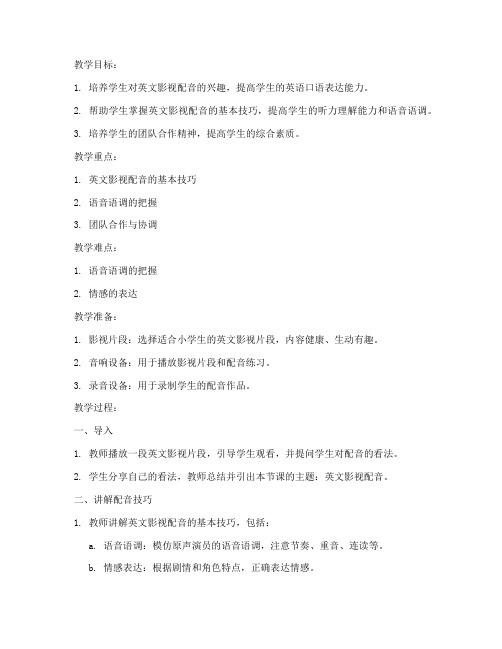
教学目标:1. 培养学生对英文影视配音的兴趣,提高学生的英语口语表达能力。
2. 帮助学生掌握英文影视配音的基本技巧,提高学生的听力理解能力和语音语调。
3. 培养学生的团队合作精神,提高学生的综合素质。
教学重点:1. 英文影视配音的基本技巧2. 语音语调的把握3. 团队合作与协调教学难点:1. 语音语调的把握2. 情感的表达教学准备:1. 影视片段:选择适合小学生的英文影视片段,内容健康、生动有趣。
2. 音响设备:用于播放影视片段和配音练习。
3. 录音设备:用于录制学生的配音作品。
教学过程:一、导入1. 教师播放一段英文影视片段,引导学生观看,并提问学生对配音的看法。
2. 学生分享自己的看法,教师总结并引出本节课的主题:英文影视配音。
二、讲解配音技巧1. 教师讲解英文影视配音的基本技巧,包括:a. 语音语调:模仿原声演员的语音语调,注意节奏、重音、连读等。
b. 情感表达:根据剧情和角色特点,正确表达情感。
c. 口型同步:尽量与原声演员的口型保持一致。
2. 学生跟随教师一起练习,教师给予个别指导。
三、分组练习1. 将学生分成若干小组,每组选择一个影视片段进行配音练习。
2. 每组学生分工明确,包括导演、配音演员、音响师等。
3. 学生在组内进行配音练习,教师巡回指导。
四、展示与评价1. 各组依次展示配音作品,教师和学生共同评价。
2. 评价内容包括:语音语调、情感表达、口型同步、团队合作等方面。
3. 对表现优秀的小组给予表扬,对不足之处提出改进意见。
五、总结与反思1. 教师对本节课进行总结,强调配音技巧的重要性。
2. 学生分享自己的学习心得,反思自己在配音过程中的收获与不足。
教学延伸:1. 组织学生参加英文影视配音比赛,提高学生的实践能力。
2. 鼓励学生在日常生活中多听、多说、多模仿,提高英语口语水平。
教学评价:1. 通过学生对配音技巧的掌握程度,评价教学效果。
2. 通过学生对配音作品的评价,了解学生的团队合作能力和综合素质。
英语配音课教案
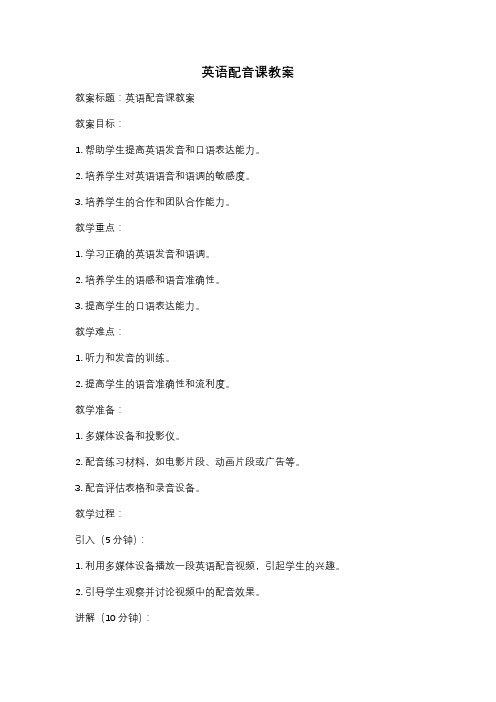
英语配音课教案教案标题:英语配音课教案教案目标:1. 帮助学生提高英语发音和口语表达能力。
2. 培养学生对英语语音和语调的敏感度。
3. 培养学生的合作和团队合作能力。
教学重点:1. 学习正确的英语发音和语调。
2. 培养学生的语感和语音准确性。
3. 提高学生的口语表达能力。
教学难点:1. 听力和发音的训练。
2. 提高学生的语音准确性和流利度。
教学准备:1. 多媒体设备和投影仪。
2. 配音练习材料,如电影片段、动画片段或广告等。
3. 配音评估表格和录音设备。
教学过程:引入(5分钟):1. 利用多媒体设备播放一段英语配音视频,引起学生的兴趣。
2. 引导学生观察并讨论视频中的配音效果。
讲解(10分钟):1. 介绍英语配音的重要性和应用领域。
2. 解释英语发音和语调的基本知识和技巧。
3. 提供一些常见的发音错误并进行纠正。
实践(25分钟):1. 分发配音练习材料,让学生自行选择一段短片进行配音练习。
2. 学生分组合作,互相练习和评估配音效果。
3. 教师巡视指导,提供个别指导和建议。
展示(10分钟):1. 邀请学生上台展示他们的配音作品。
2. 全班共同评估和讨论每个学生的表现。
3. 教师给予肯定和鼓励,并提供进一步的建议。
总结(5分钟):1. 总结本节课的学习内容和收获。
2. 引导学生思考如何继续提高英语发音和语调。
3. 布置下节课的预习任务。
教学延伸:1. 鼓励学生参与英语配音比赛或演出,提高他们的自信心和表达能力。
2. 提供更多的配音练习材料和资源,让学生继续锻炼和提高。
评估方式:1. 观察学生在实践环节中的表现和进步。
2. 评估学生的配音作品,包括发音准确性、语调流畅性和表达能力。
3. 记录学生的配音评估结果,以便后续的个别指导和评估。
教案撰写的过程中,我会根据不同教育阶段的要求,结合学生的年龄、英语水平和学习需求,进行教学目标、重点和难点的调整。
同时,我会根据实际情况进行教学过程的具体安排和教学方法的选择。
英语配音教案

英语配音教案教案标题:英语配音教案教学目标:1. 培养学生对英语语音的敏感度和准确性。
2. 提高学生的英语口语表达能力和语音语调的流利性。
3. 培养学生的听力理解能力和语音模仿能力。
教学重点:1. 学习正确的英语发音和语音语调。
2. 运用所学的语音知识进行英语配音练习。
3. 提高学生的语音模仿和表达能力。
教学准备:1. 英语配音练习材料(如电影片段、短视频等)。
2. 录音设备或电脑音频播放器。
3. 学生用纸和笔。
教学步骤:引入活动:1. 向学生介绍英语配音的概念,并解释其重要性和应用场景。
2. 播放一段有英语配音的视频片段,让学生感受配音的效果,并引发学生对配音的兴趣。
知识讲解:1. 介绍英语中常见的发音规则和语音语调。
2. 分析一些常见的发音错误,并提供正确的发音示范。
3. 给学生提供一些发音练习的口诀或技巧,帮助他们记忆和运用。
配音练习:1. 分发英语配音练习材料,让学生阅读并理解其中的对话内容。
2. 播放配音练习材料的原始音频,让学生听并模仿其中的语音语调。
3. 让学生分组进行配音练习,每组选择一段对话进行配音。
4. 学生进行配音练习时,教师可以提供指导和反馈,帮助他们改善发音和语音语调。
展示和评价:1. 让每个小组轮流展示他们的配音作品。
2. 学生互相评价和给予建议,鼓励积极的反馈和改进。
3. 教师对每个小组的配音作品进行评价,并提供针对性的建议和指导。
总结和延伸:1. 总结本节课所学的英语发音和语音语调知识。
2. 鼓励学生在日常生活中继续进行英语配音练习,如模仿电影台词、录制自己的配音作品等。
3. 提供相关的学习资源和推荐书籍,帮助学生深入学习和提高英语配音技巧。
拓展活动:1. 组织学生参加英语配音比赛或表演,展示他们的配音才华。
2. 邀请专业配音演员或教师进行讲座或示范,帮助学生更深入地了解英语配音的技巧和要点。
教学反思:1. 教师应密切关注学生的发音情况,及时给予指导和纠正。
2. 配音练习过程中,要注重培养学生的语音语调感知和模仿能力。
《Big Hero电影片段配音》教学设计

《Big Hero电影片段配音》教学设计英语教学是现阶段教育的一个重要组成部分,而口语一直是中学生学习的薄弱环节。
然而在一个非英语的环境里,学生很难在真实的语境中将已被输入的知识自然而真实的输出。
针对这种教学现状,英文原声电影配音可以作为课堂教学的有力补充。
一方面,电影配音弥补了传统课堂教学中师生及生生之间交流机会少的弊端,使学生的学习成果可以直接运用,有利于学生在实际运用中真正熟练的掌握英语。
另一方面,将活动作为学习的载体,电影配音可以有力促进活动化教学的开展,进而提高学生的口语交流能力,培养学生的英语学习兴趣。
二、教学分析1.教学内容分析本节课是校本课程Happy English Club第五课时。
本节课以学生自主选取的电影Big Hero片段为依托,学生自主模仿语音语调,揣摩角色特点,完成配音并分小组汇报表演。
在前几模块的学习中,学生已经对电影背景有了大致了解并完成了影片的欣赏,而本节课的配音练习恰恰就是帮助学生提升口语、感知文化的一个非常好的载体。
2.教学对象分析通过对前几个模块的学习,学生已经对英文电影有了初步的了解。
通过上一课时的影视欣赏,学生们已熟识Big Hero 里面的主要角色,并对角色的性格特点也有了初步了解。
然而真正的做到原声配音对学生来说还是有一定难度的。
学生在已有知识的基础上,运用自主探究、小组合作、实践体验的学习方法,通过本课的学习会感受到原声语言的魅力同时提升对英语的兴趣。
3.教学环境分析网络教室环境的选择:本课的故事性可以为学生提供非常经典的动画视频,并通过在网络教室的教学环境中,通过学生与信息资源互动的多维学习方式,实现学生视、听、说、做的学习目的,有效的实现英语教学目标。
三、教学目标1.以学生的接受能力为基础,以英语原版影视片断为教学平台,通过视,听,说,读相结合的方法,借助声音,图像和文本等多重信息,提升学生的英语表达能力。
2.通过节选影片的配音实践,激发学生的表演才能,提高学生的艺术素养。
高中英语配音社团教案模板
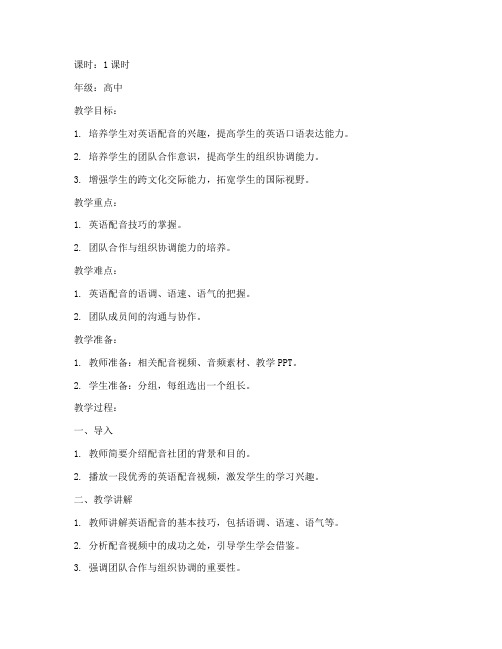
课时:1课时年级:高中教学目标:1. 培养学生对英语配音的兴趣,提高学生的英语口语表达能力。
2. 培养学生的团队合作意识,提高学生的组织协调能力。
3. 增强学生的跨文化交际能力,拓宽学生的国际视野。
教学重点:1. 英语配音技巧的掌握。
2. 团队合作与组织协调能力的培养。
教学难点:1. 英语配音的语调、语速、语气的把握。
2. 团队成员间的沟通与协作。
教学准备:1. 教师准备:相关配音视频、音频素材、教学PPT。
2. 学生准备:分组,每组选出一个组长。
教学过程:一、导入1. 教师简要介绍配音社团的背景和目的。
2. 播放一段优秀的英语配音视频,激发学生的学习兴趣。
二、教学讲解1. 教师讲解英语配音的基本技巧,包括语调、语速、语气等。
2. 分析配音视频中的成功之处,引导学生学会借鉴。
3. 强调团队合作与组织协调的重要性。
三、分组练习1. 学生分组,每组选出一个组长。
2. 每组根据教师提供的素材,进行配音练习。
3. 教师巡回指导,帮助学生解决配音过程中的问题。
四、展示与评价1. 各组展示配音作品,其他小组进行评价。
2. 教师对各组的表现进行点评,指出优点和不足。
3. 鼓励学生积极参与,勇于表现自己。
五、总结与反思1. 教师总结本节课的学习内容,强调配音技巧和团队合作的重要性。
2. 学生分享自己的学习心得,反思自己在配音过程中的表现。
3. 教师鼓励学生在课后继续练习,提高自己的英语配音水平。
教学评价:1. 学生在配音过程中的表现,如语调、语速、语气等。
2. 学生在团队合作中的表现,如沟通、协作等。
3. 学生对英语配音的兴趣和热情。
课后作业:1. 每位学生选取一段自己喜欢的英语配音视频,分析其配音技巧。
2. 每组根据教师提供的素材,完成一段英语配音作品,并提交给教师。
教学反思:本节课通过英语配音活动,激发了学生的学习兴趣,提高了学生的英语口语表达能力。
在团队合作过程中,学生的组织协调能力和沟通能力得到了锻炼。
英文电影配音课程教学大纲
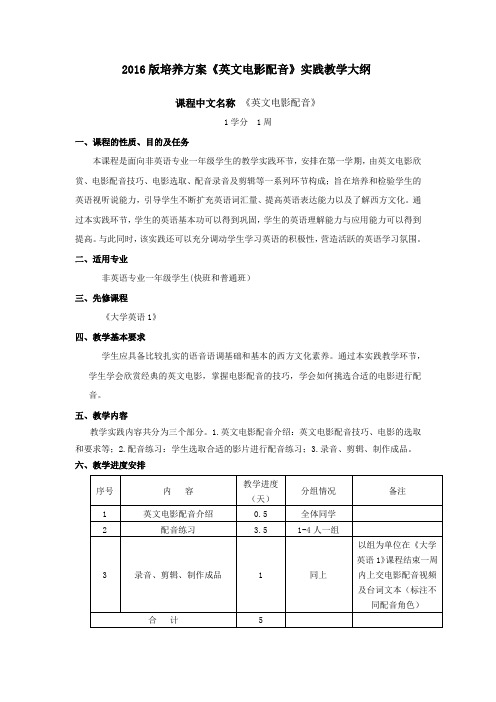
2016版培养方案《英文电影配音》实践教学大纲课程中文名称《英文电影配音》1学分 1周一、课程的性质、目的及任务本课程是面向非英语专业一年级学生的教学实践环节,安排在第一学期,由英文电影欣赏、电影配音技巧、电影选取、配音录音及剪辑等一系列环节构成;旨在培养和检验学生的英语视听说能力,引导学生不断扩充英语词汇量、提高英语表达能力以及了解西方文化。
通过本实践环节,学生的英语基本功可以得到巩固,学生的英语理解能力与应用能力可以得到提高。
与此同时,该实践还可以充分调动学生学习英语的积极性,营造活跃的英语学习氛围。
二、适用专业非英语专业一年级学生(快班和普通班)三、先修课程《大学英语1》四、教学基本要求学生应具备比较扎实的语音语调基础和基本的西方文化素养。
通过本实践教学环节,学生学会欣赏经典的英文电影,掌握电影配音的技巧,学会如何挑选合适的电影进行配音。
五、教学内容教学实践内容共分为三个部分。
1.英文电影配音介绍:英文电影配音技巧、电影的选取和要求等;2.配音练习:学生选取合适的影片进行配音练习;3.录音、剪辑、制作成品。
六、教学进度安排七、主要参考书[1] 施玲. 2014. 电影电视配音艺术. 杭州:浙江大学出版社.[2] 王明军,阎亮. 2014. 影视配音实用教程. 北京:中国传媒大学出版社.[3] 王明军,阎亮. 2015. 影视配音艺术丛书. 北京:中国传媒大学出版社.八、评价方式根据学生完成配音作品的情况,主要包括电影作品配音难度、语音语调、配音表现力、台词文本长度等将其分为优秀、良好、中等、及格和不及格五个等级。
小组内成员得分可以有区别。
具体评分标准如下:。
英文电影配音选修课教案

《原音影视配音与英语学习》 Big Hero 6教学设计(第一课时)xx民族师范学院附属中学英语组 xx银一.教学目标以学生的接受能力为基准,借助精彩的英语原版影视片断为教学平台,采取视,听,说,读相结合的手段,注重课堂教学的实效性和操作性,在声音,图像和文本多重信息作用下,使学生的英语表达能力得到较快提升。
通过影片的配音实践,激发学生的表演才能,提高学生的艺术素养;走进影片主人公的精神世界,不自觉的和影片主人公产生心灵的共鸣,反映出深刻的理性内涵,激发学生的道德需要,调动学生主动追求高尚人格,利用影片强烈的教育功能和强大的教育征服力,培养学生xx的情感。
二.教学重点通过对电影Big Hero 6 的欣赏及配音表演使学生的英语表达能力得到较快提升,激发学生的表演才能,提高学生的艺术素养。
三.教学难点如何让学生在课堂上大胆的模仿电影人物的声音及神态,把配音效果发挥到最好的水平。
四.教学步骤Step 1. Warming upGreet the students as usual.Step 2. Introduce the main character of this this movie.小宏Hiro大白Baymax弗雷德Fred神行御姐Go Go芥末无疆Wasabi哈妮柠檬Honey Lemon卡斯阿姨Aunt Cass卡拉汉教授Professor CallaghanStep 3. Make a self Brief introduction of the movie.Teacher introduce the introduction of this movie and show it on the screen.Step 4. Students enjoy some wonderful parts of the movie.Step 5. Teacher introduce some useful words and sentences to the students.And students practice the sentences together.1. House rules: You gotta to pay to play.2.No one likes a sore loser.3. I’m surprised as you are.4. Beginner’s luck.5. Good timing.6. Bot fighting is illegal. You’re gonna get yourself arrested.7. For the ten years, I heed the best I could to raise you.8. I had to close up early because of you two fellas on beat poetry night.Step 6. The teacher chooses a wonderful part of this movie for the studentsto enjoy and then students imitate the voice of the character of this movieto practice the conversation in it.Step 7. Students practice the part they want to act in group.Students practice the conversations in the movie. Teacher walk aroundthe classroom and give them some commons if necessary.Step 8. Students come to the front and have a performance.Students come to the front and act out their work group by group.Step 9 HomeworkStudents practice the important sentences they have learned this period.附:原声配音文本材料:人物:Hiro (xx) ..HYama (xx).…Y Host(机器人比赛主持人) Tadashi(啊正).....TAunt Cass (卡斯xx)….C第一幕:xx自制的小机器人参加机器人赌博比赛,并获胜。
初中社团英语配音教案
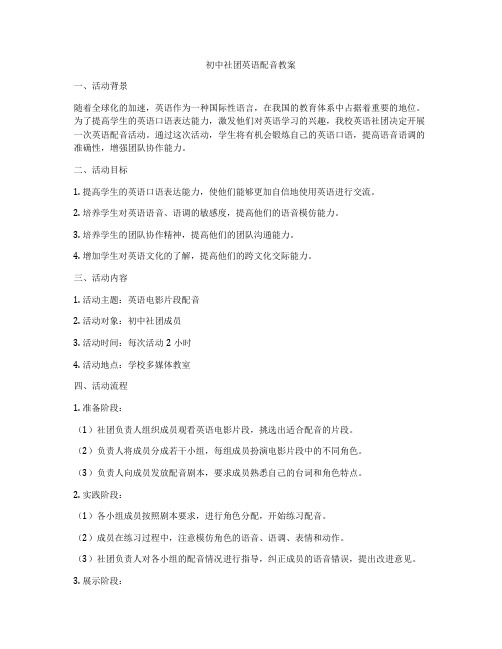
初中社团英语配音教案一、活动背景随着全球化的加速,英语作为一种国际性语言,在我国的教育体系中占据着重要的地位。
为了提高学生的英语口语表达能力,激发他们对英语学习的兴趣,我校英语社团决定开展一次英语配音活动。
通过这次活动,学生将有机会锻炼自己的英语口语,提高语音语调的准确性,增强团队协作能力。
二、活动目标1. 提高学生的英语口语表达能力,使他们能够更加自信地使用英语进行交流。
2. 培养学生对英语语音、语调的敏感度,提高他们的语音模仿能力。
3. 培养学生的团队协作精神,提高他们的团队沟通能力。
4. 增加学生对英语文化的了解,提高他们的跨文化交际能力。
三、活动内容1. 活动主题:英语电影片段配音2. 活动对象:初中社团成员3. 活动时间:每次活动2小时4. 活动地点:学校多媒体教室四、活动流程1. 准备阶段:(1)社团负责人组织成员观看英语电影片段,挑选出适合配音的片段。
(2)负责人将成员分成若干小组,每组成员扮演电影片段中的不同角色。
(3)负责人向成员发放配音剧本,要求成员熟悉自己的台词和角色特点。
2. 实践阶段:(1)各小组成员按照剧本要求,进行角色分配,开始练习配音。
(2)成员在练习过程中,注意模仿角色的语音、语调、表情和动作。
(3)社团负责人对各小组的配音情况进行指导,纠正成员的语音错误,提出改进意见。
3. 展示阶段:(1)各小组成员在多媒体教室进行配音展示,其他社团成员观看。
(2)评委对各小组的配音情况进行评分,评选出最佳配音小组和最佳配音演员。
(3)社团负责人对活动进行总结,对获奖小组和演员进行表彰。
五、活动注意事项1. 活动前,社团负责人要充分了解学生的英语水平,挑选适合他们的电影片段。
2. 活动中,社团负责人要关注每个成员的参与情况,鼓励他们大胆开口说英语。
3. 活动后,社团负责人要及时总结活动经验,为下次活动提供参考。
4. 重视学生的跨文化交际能力培养,引导他们在配音过程中了解和尊重英语国家的文化习俗。
英语配音故事教案模板范文
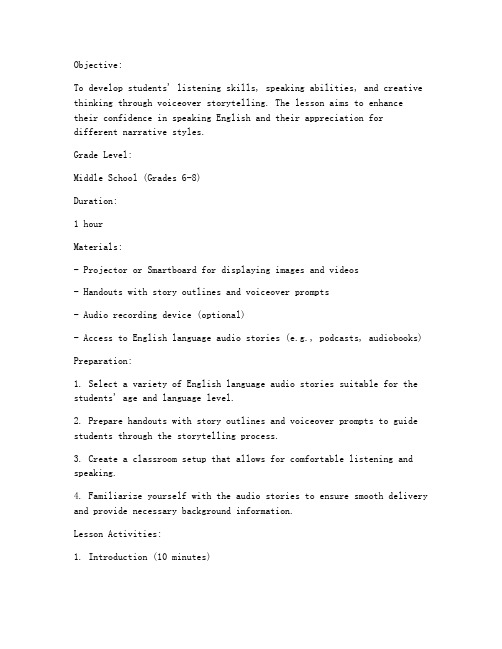
Objective:To develop students' listening skills, speaking abilities, and creative thinking through voiceover storytelling. The lesson aims to enhancetheir confidence in speaking English and their appreciation fordifferent narrative styles.Grade Level:Middle School (Grades 6-8)Duration:1 hourMaterials:- Projector or Smartboard for displaying images and videos- Handouts with story outlines and voiceover prompts- Audio recording device (optional)- Access to English language audio stories (e.g., podcasts, audiobooks)Preparation:1. Select a variety of English language audio stories suitable for the students' age and language level.2. Prepare handouts with story outlines and voiceover prompts to guide students through the storytelling process.3. Create a classroom setup that allows for comfortable listening and speaking.4. Familiarize yourself with the audio stories to ensure smooth delivery and provide necessary background information.Lesson Activities:1. Introduction (10 minutes)- Begin the class by discussing the concept of voiceover storytelling and its significance in media.- Show a short video clip or audio snippet from a well-known voiceover story to spark interest and provide a reference point.2. Warm-Up Activity (10 minutes)- Engage students in a group discussion about their favorite stories and why they enjoy them.- Encourage them to share their thoughts on different narrativestyles and the impact of voice in storytelling.3. Story Analysis (15 minutes)- Present a short English audio story to the class.- Ask students to listen actively and take notes on key elements such as plot, characters, and setting.- Discuss the story as a group, focusing on the voiceover techniques used and the emotions evoked.4. Voiceover Practice (20 minutes)- Divide the class into small groups and provide each group with a story outline and voiceover prompts.- Instruct students to choose a character from the story and practice voicing their dialogue, considering the character's personality and context.- Encourage students to use different tones, accents, and expressions to bring their characters to life.5. Recording Session (15 minutes)- Allow each group to record their voiceover story using the audio recording device.- Remind students to speak clearly and project their voices forbetter audibility.6. Sharing and Feedback (10 minutes)- Play back the recorded voiceover stories for the class.- Encourage students to provide constructive feedback on each other's performances.- Discuss the strengths and areas for improvement in each voiceover.7. Reflection and Conclusion (5 minutes)- Ask students to reflect on their experience with voiceover storytelling.- Discuss the importance of voice in storytelling and how it can enhance the listener's experience.- Summarize the key points of the lesson and encourage students to explore more voiceover stories on their own.Assessment:- Evaluate students' participation in group discussions and activities.- Assess the quality of their voiceover performances based on clarity, expression, and adherence to character descriptions.- Provide individual feedback on areas where students can improve.Homework:- Assign students to listen to a new English audio story and write a short reflection on the voiceover techniques used.- Encourage them to practice their own voiceover storytelling skills at home.Note:This lesson plan can be adapted to different age groups and language proficiency levels by selecting appropriate stories and adjusting the complexity of the voiceover prompts.。
高中英语配音指导教案模板
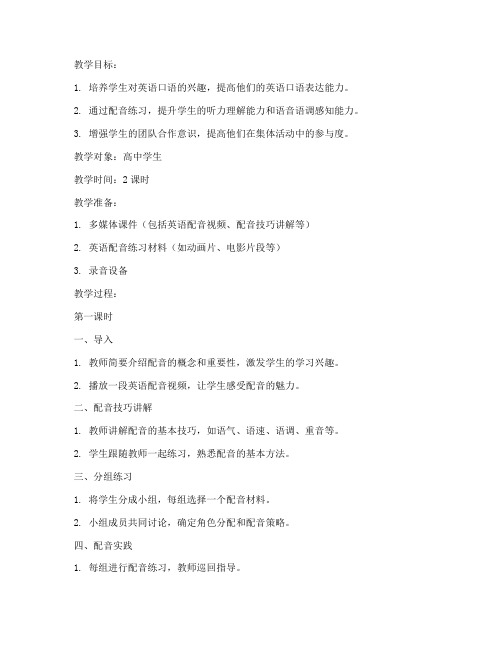
教学目标:1. 培养学生对英语口语的兴趣,提高他们的英语口语表达能力。
2. 通过配音练习,提升学生的听力理解能力和语音语调感知能力。
3. 增强学生的团队合作意识,提高他们在集体活动中的参与度。
教学对象:高中学生教学时间:2课时教学准备:1. 多媒体课件(包括英语配音视频、配音技巧讲解等)2. 英语配音练习材料(如动画片、电影片段等)3. 录音设备教学过程:第一课时一、导入1. 教师简要介绍配音的概念和重要性,激发学生的学习兴趣。
2. 播放一段英语配音视频,让学生感受配音的魅力。
二、配音技巧讲解1. 教师讲解配音的基本技巧,如语气、语速、语调、重音等。
2. 学生跟随教师一起练习,熟悉配音的基本方法。
三、分组练习1. 将学生分成小组,每组选择一个配音材料。
2. 小组成员共同讨论,确定角色分配和配音策略。
四、配音实践1. 每组进行配音练习,教师巡回指导。
2. 鼓励学生大胆尝试,勇于表达。
五、展示与评价1. 每组展示配音作品,其他小组进行评价。
2. 教师对各组的表现进行点评,指出优点和不足。
第二课时一、复习与巩固1. 教师播放上节课的配音视频,让学生回顾配音技巧。
2. 学生分享自己的配音心得,互相学习。
二、拓展练习1. 教师提供新的配音材料,让学生进行拓展练习。
2. 学生分组,选择角色,进行配音。
三、配音比赛1. 各组进行配音比赛,评选出最佳配音小组。
2. 邀请其他同学担任评委,评选出最佳配音演员。
四、总结与反思1. 教师总结配音课程的学习成果,强调配音技巧的重要性。
2. 学生分享自己的收获和感悟,提出改进建议。
教学评价:1. 观察学生在配音过程中的表现,评价他们的口语表达能力和团队合作精神。
2. 评价学生在配音比赛中的表现,包括配音技巧、角色塑造、情感表达等方面。
3. 收集学生反馈意见,改进教学方法和内容。
教学反思:1. 教师反思配音课程的设计是否合理,教学方法是否有效。
2. 教师总结学生在配音过程中的优点和不足,为后续教学提供参考。
英语配音教学教案模板
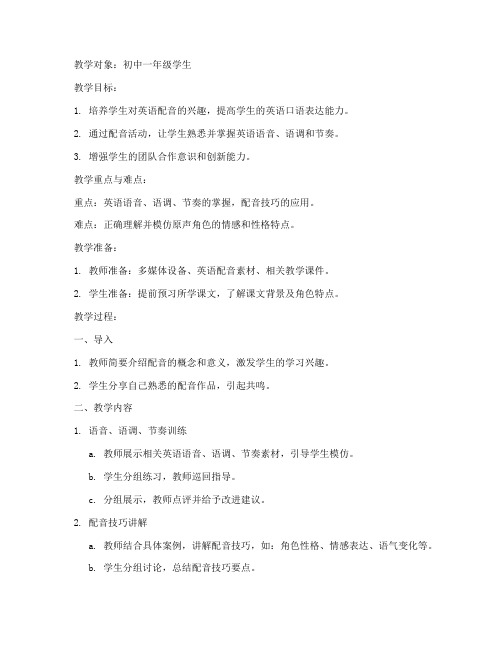
教学对象:初中一年级学生教学目标:1. 培养学生对英语配音的兴趣,提高学生的英语口语表达能力。
2. 通过配音活动,让学生熟悉并掌握英语语音、语调和节奏。
3. 增强学生的团队合作意识和创新能力。
教学重点与难点:重点:英语语音、语调、节奏的掌握,配音技巧的应用。
难点:正确理解并模仿原声角色的情感和性格特点。
教学准备:1. 教师准备:多媒体设备、英语配音素材、相关教学课件。
2. 学生准备:提前预习所学课文,了解课文背景及角色特点。
教学过程:一、导入1. 教师简要介绍配音的概念和意义,激发学生的学习兴趣。
2. 学生分享自己熟悉的配音作品,引起共鸣。
二、教学内容1. 语音、语调、节奏训练a. 教师展示相关英语语音、语调、节奏素材,引导学生模仿。
b. 学生分组练习,教师巡回指导。
c. 分组展示,教师点评并给予改进建议。
2. 配音技巧讲解a. 教师结合具体案例,讲解配音技巧,如:角色性格、情感表达、语气变化等。
b. 学生分组讨论,总结配音技巧要点。
3. 配音实践a. 教师选取适合的英语配音素材,让学生分组进行配音。
b. 学生在规定时间内完成配音任务,教师巡回指导。
c. 分组展示配音作品,教师点评并给予改进建议。
三、教学活动1. 角色扮演:学生分组扮演不同角色,进行英语对话或情景表演。
2. 配音比赛:学生自选配音素材,进行个人或团队配音比赛。
四、教学总结1. 教师总结本节课的学习内容,强调配音技巧的重要性。
2. 学生分享自己的学习心得和收获。
3. 布置课后作业,鼓励学生课后进行配音练习。
教学反思:1. 教师应根据学生的实际情况,调整教学内容和方法,提高教学效果。
2. 注重培养学生的团队合作意识和创新能力,激发学生的学习兴趣。
3. 及时关注学生的学习进度,给予学生充分的指导和鼓励。
英语配音教案_2
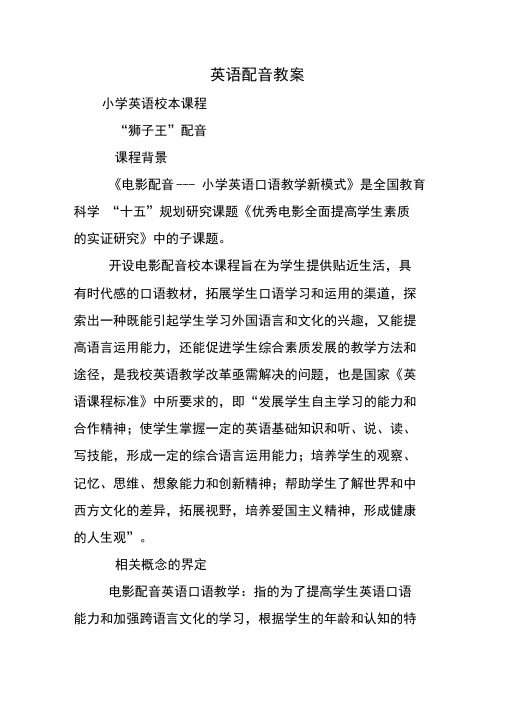
英语配音教案小学英语校本课程“狮子王”配音课程背景《电影配音--- 小学英语口语教学新模式》是全国教育科学“十五”规划研究课题《优秀电影全面提高学生素质的实证研究》中的子课题。
开设电影配音校本课程旨在为学生提供贴近生活,具有时代感的口语教材,拓展学生口语学习和运用的渠道,探索出一种既能引起学生学习外国语言和文化的兴趣,又能提高语言运用能力,还能促进学生综合素质发展的教学方法和途径,是我校英语教学改革亟需解决的问题,也是国家《英语课程标准》中所要求的,即“发展学生自主学习的能力和合作精神;使学生掌握一定的英语基础知识和听、说、读、写技能,形成一定的综合语言运用能力;培养学生的观察、记忆、思维、想象能力和创新精神;帮助学生了解世界和中西方文化的差异,拓展视野,培养爱国主义精神,形成健康的人生观”。
相关概念的界定电影配音英语口语教学:指的为了提高学生英语口语能力和加强跨语言文化的学习,根据学生的年龄和认知的特点,选用英语电影片段进行口语教学的一种模式。
利用英文原版电影,通过上电影配音课,开展相关的电影活动,能创设英语口语教学的良好环境,优化英语课堂教学,激发学生学习的兴趣和动机,提高学生的综合素质,并总结提高学生英语口语能力的有效方法和途径。
理论依据英语视听教学方法视听教学法以主张视、听并用而得名,它强调耳、眼、脑等感官作为整体去感知语言材料。
而电影为学生创造了“声、光、色、像”无限拓展的立体环境,为学习奠定了很好的基础。
美国教育学者研究发现:我们从视觉获得的80% 的知识,但仅记住了它的11%。
听觉和视觉的组合可以获得更高的效率,使记忆的东西由5%上升到50%。
体验教育理论使英语生活化的过程中, 采用创设情景的方法进行英语口语教学, 让学生体验配音学习过程,体验电影剧本中人物的情感,体验电影主题的思想,以及体验自己取得的成就,从而激发起更大的学习热情。
加德纳多元智能理论多元智能理论认为人的智能是多元的,每个人有7 种不同类型的智能:1. 言语- 语言智能。
- 1、下载文档前请自行甄别文档内容的完整性,平台不提供额外的编辑、内容补充、找答案等附加服务。
- 2、"仅部分预览"的文档,不可在线预览部分如存在完整性等问题,可反馈申请退款(可完整预览的文档不适用该条件!)。
- 3、如文档侵犯您的权益,请联系客服反馈,我们会尽快为您处理(人工客服工作时间:9:00-18:30)。
英文电影配音选修课教案精选文档TTMS system office room 【TTMS16H-TTMS2A-TTMS8Q8-《原音影视配音与英语学习》 Big Hero 6教学设计(第一课时)广西民族师范学院附属中学英语组宁庆银一.教学目标以学生的接受能力为基准,借助精彩的英语原版影视片断为教学平台,采取视,听,说,读相结合的手段,注重课堂教学的实效性和操作性,在声音,图像和文本多重信息作用下,使学生的英语表达能力得到较快提升。
通过影片的配音实践,激发学生的表演才能,提高学生的艺术素养;走进影片主人公的精神世界,不自觉的和影片主人公产生心灵的共鸣,反映出深刻的理性内涵,激发学生的道德需要,调动学生主动追求高尚人格,利用影片强烈的教育功能和强大的教育征服力,培养学生真善美的情感。
二.教学重点通过对电影Big Hero 6 的欣赏及配音表演使学生的英语表达能力得到较快提升,激发学生的表演才能,提高学生的艺术素养。
三.教学难点如何让学生在课堂上大胆的模仿电影人物的声音及神态,把配音效果发挥到最好的水平。
四.教学步骤Step 1. Warming upGreet the students as usual.Step 2. Introduce the main character of this this movie.Step 3. Make a self Array Brief introduction of the movie.Teacher introduce the introduction of this movie and show it on the screen.Step 4. Students enjoy some wonderful parts of the movie.Step 5. Teacher introduce some useful words and sentences to the students.And students practice the sentences together.1. House rules: You gotta to pay to play.2.No one likes a sore loser.3. I’m surprised as you are.4. Beginner’s luck.5. Good timing.6. Bot fighting is illegal. You’re gonna get yourself arrested.7. For the ten years, I heed the best I could to raise you.8. I had to close up early because of you two fellas on beat poetry night.Step 6. The teacher chooses a wonderful part of this movie for the studentsto enjoy and then students imitate the voice of the character of this movieto practice the conversation in it.Step 7. Students practice the part they want to act in group.Students practice the conversations in the movie. Teacher walk aroundthe classroom and give them some commons if necessary.Step 8. Students come to the front and have a performance.Students come to the front and act out their work group by group.Step 9 HomeworkStudents practice the important sentences they have learned this period.附:原声配音文本材料:人物:Hiro (小宏) ..H Yama (阎王).…Y Host(机器人比赛主持人) Tadashi(啊正).....T Aunt Cass (卡斯阿姨)….C第一幕:小宏自制的小机器人参加机器人赌博比赛,并获胜。
结果对手不服气,吩咐手下给小宏点颜色看看。
Host: The winner! By total annihilation. Yama! 赢家诞生! 完胜对手!催命阎王!Y: who’s nextWhere’s the guts to stop me in the ringWith little Yama!谁是下一个谁还有胆量在赛场上一决雌雄挑战我的小阎王H: Can I tryI have a robot. I built it myself.Y: Ha ha…Host:Beat it kid! House rules: You gotta to pay to play.算了吧小子。
这儿有规矩,交钱才能入场。
H: Oh, it’s this enoughY: what’s your name, little boy?H: Hiro, Hiro Hamada.Y: Prepare your bot, zero(小虫)…Host: Two bots enter. One might leaves. Fighters readyFight!双方对决,决一死战。
Y: Ha ha …H: That was my first fight. Can I try againY: No one likes a sore loser. Little boy! Go home.没人喜欢输不起的人,小朋友。
H: I’ve got more money.Host: Fighters readyFight!H: Megabot! Destroy. 磁力神。
灭了它!H: No more little Yama. 再见了小阎王。
Y: But what That is not possible.H: Hey, I’m surprised as you are. Beginner’s luck. Do you like to go againYama?我也没想到,也许是新手运气好吧。
Y: No one hastles Yama! Teach him a lesson!没人敢惹阎王!给他点颜色看看。
H: Hey fellas. Let’s talk about this.伙计们,有话好好说。
第二幕:小宏的哥哥阿正赶来救小宏。
后来小宏和哥哥被警察带到警察局。
T: Hiro, get on!H; Tadashi! Ooh! Good timing. 来得正是时候。
T: Are you ok?H: Yeah!T: Are you hurt?H: No.T: Then what are you thinking, knuckle head(笨蛋)You graduated high school and you’re 13 and this is what you’re doing?你13岁从高中毕业就为了干这个?Hold on!Bot fighting is illegal. You’re gonna get yourself arrested.机器人比赛是违法的。
你会被抓进监狱的。
H: Bot fighting is not illegal. Betting on bot fighting …that’s… that’s illegal.机器人比赛不违法参与赌博才违法。
But, so who could heedI’m on a roll.,big brother. And there is no stopping me!但没人会注意到的,我势头课猛了,老哥。
谁也不能阻止我。
T: Oh, no.第三幕:小宏的阿姨到警察局领回小宏和哥哥,并对他们的所作所为非常生气。
H:Hi, Aunt Cass.C: Are you guys ok Tell me you’re ok?H/T: We are fine.C: Oh, good.C: Then what are you two knuckle heads thinking!For the ten years, I heed the best I could to raise you.过去十年我含辛茹苦的把你们拉扯大。
Have I been perfectNo!Do I know anything about childrenNo !Should I pick a book on parentingProbably!我该找本育儿手册来看看吗也许吧!Where I was going with thisI had a point…我想说什么来着我本来想说。
T: Sorry.H: I love you, Aunt Cass.C: I love you too!I had to close up early because of you two fellas on beat poetry night.因为你俩,我不得不在节拍诗之夜早早就手工。
Stress eating because of you! Come on, Moty.因为你俩我都暴饮暴食了。
过来,糯米。
This is really good.。
